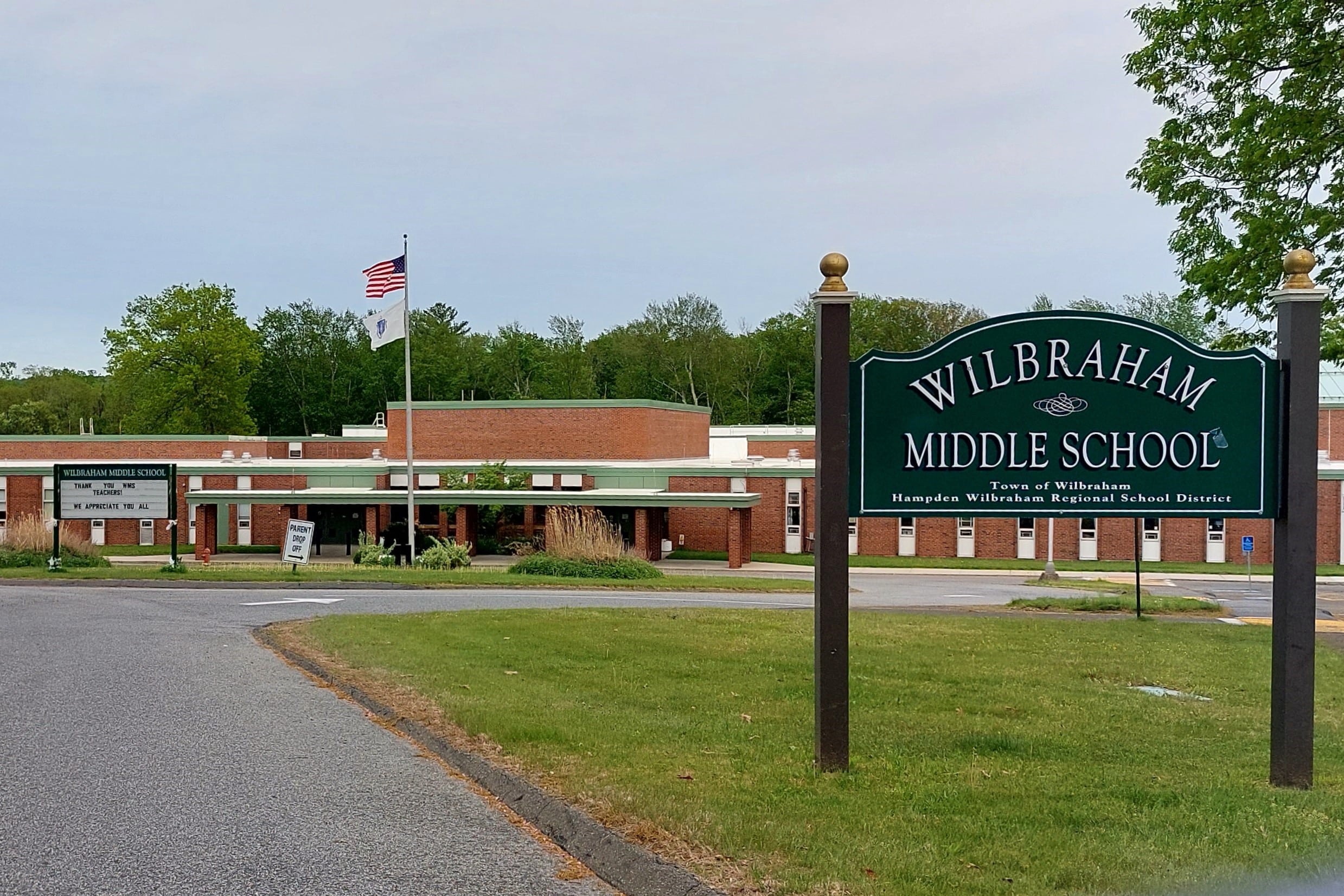Talks between the leadership in Hampden and Wilbraham on proposed revisions to the regional agreement governing the schools have broken down. The sticking point hinges on who should pay for capital expenses at Wilbraham Middle School, which students from both towns attend.
The Hampden-Wilbraham Regional School District Planning Committee, which included members of the Hampden Selectboard and Wilbraham Select Board, began working on revising the regional agreement in 2023. The undertaking was called for in the district’s Strategic Plan. Since then, the Planning Committee has examined each section of the regional agreement, proposing changes as they went.
The School Committee approved the draft of the changes earlier this year and received feedback from the state Department of Elementary and Secondary Education. Town leadership decided to host joint meetings to hammer out a few issues and find common ground. One of those issues was capital investments at the middle school, which Wilbraham owns and leases to the district.
When Thornton W. Burgess Middle School was closed in 2018, some of Hampden’s middle school students moved to Green Meadows School while others went to the middle school in Wilbraham. Over the years, however, more parents transferred their children to Wilbraham Middle School for educational parity, until last year, when there were no longer enough students at Green Meadows to support a middle school program of studies.
The regional agreement draft revisions states, “When the district assigns students from any grade(s) from both member towns to a single school building, which single school building is a leased building, that building will be treated as a district-owned building and capital costs will be apportioned on the basis of the ratio that the number of students from each member towns bears to the total foundation enrollment from both member towns in the grades served by the school.”
The two select boards met in-person twice to discuss this provision. On April 11, Wilbraham Town Administrator Nick Breault sent Hampden Town Administrator Brain Domina a letter stating, “A majority of the Wilbraham Select Board favors the proposal as written in the [regional agreement proposal]. They think the Wilbraham Middle School capital costs should be handled as if the building is a district building, similar to Minnechaug Regional High School” and split in keeping with enrollment, with 82% paid by Wilbraham and 18% paid by Hampden.
As Bunnell put it to Reminder Publishing on May 9, “To some extent, the middle school has been a regional school for some time” because students from both towns are educated there.
As is the case with capital improvements to Minnechaug, any capital project at the middle school would require approval at each town’s Town Meeting. “Both towns would have equal weight in moving forward with [capital projects], even though there isn’t an equal cost burden,” Bunnell said.
A suggestion from Hampden was for the towns to develop a list of “carve outs,” projects outlined in a 2015 survey of the building that have yet to be completed. When it came to the carve-outs Hampden requested, Bunnell said it was “a hard no” from the Wilbraham Select Board.
“Rationale for this majority opinion includes doubt about the relevance of a study from 10 years ago, and the reality that the middle school capital projects approved by both communities going forward will benefit the students from both communities,” Breault wrote. He added, “Town Meeting approval by both communities is, in effect, a carve-out procedure. If one or both communities do not vote to support a given middle school capital project, it is effectively carved out,” Breault stated in his letter to Hampden.
Rejecting what she sees as an implication that Wilbraham was waiting years to conduct the repairs so Hampden would be compelled to pay for part of them, she said that Wilbraham’s Capital Planning Committee reviews projects each year and prioritizes them based on need.
“There were some improvements made above and beyond the condition of the roof,” which was replaced a few years ago through the Massachusetts School Building Authority’s Accelerated Repair Program, but “nobody’s really inclined to put millions of dollars into a 50-year-old building,” Bunnell said.
After discussing Wilbraham’s positions, the Hampden Selectboard instructed Domina to relay that, “Given the positions outlined in the April 11 memorandum, it is the board’s view that further discussions would be unproductive. Further, the Hampden Selectboard recommends that the Hampden Wilbraham Regional School Committee prepare and place before the voters of Wilbraham and Hampden the proposed amendments at each of the respective Special Fall Town Meetings.”
The Hampden Selectboard disputed the statement by their counterparts that the 2015 study was not relevant. To that point, it cited a mold issue at the school at the beginning of the 2024-25 school year which caused a loss of learning days. This could have been prevented by the replacement of vents spelled out in the study.
As to the idea of Wilbraham waiting to repair the issues cited in the 2015 building survey, Domina cited a March 13 Wilbraham Capital Planning Committee meeting in which the district requested $700,000 to replace the vents. He quoted the Capital Planning Committee chair as saying the possibility of regionalization was part of the reason to not fund the project.
“So clearly, a major factor in the decision to postpone this urgent project at the Wilbraham Middle School was based on the possibility of Hampden taxpayers being asked to fund a portion of this and projects in the future and that the urgent health and safety concern for the students of the district as presented by HWRSD was disregarded.”
Bunnell said, “There was no clear message” that not replacing the vents would lead to mold at the school. On the current situation regarding the mold, she said, “The state inspectors have signed off on the condition of the building.”
Domina’s letter also explained that carve outs are not new to Wilbraham. “The concept was recognized previously when the roof replacement was ‘carved out’ in a 2016 Wilbraham Special Town Meeting warrant article.” He continued, “At that time, the following was reported in the Wilbraham-Hampden Times, ‘The district is proposing that the towns of Hampden and Wilbraham amend the regional agreement to allow Hampden students to be educated at [Wilbraham Middle School] for a period of five years. The plan calls for leasing modular classrooms to accommodate the combined sixth through eighth student body of the two towns. Operational costs of the unified building will be assumed according to the town’s assessment except for any pre-existing costs, such as the roof, which will be the responsibility of Wilbraham.’”
Because the proposed updates to the regional agreement are slated to be presented as a single article at the fall town meetings, the whole proposal could fail if residents in one town or the other object to the middle school issue.
In an email, HWRSD Superintendent John Provost said, “Most of the changes in the proposed restated regional agreement reflect changes to state regulations that have come into effect since the agreement was last updated. I believe this [process] has been instructive and has resulted in many shared understandings. Setting aside any sticking points, I believe that the work that has been done to bring the agreement up to date with current regulations will be helpful.”



